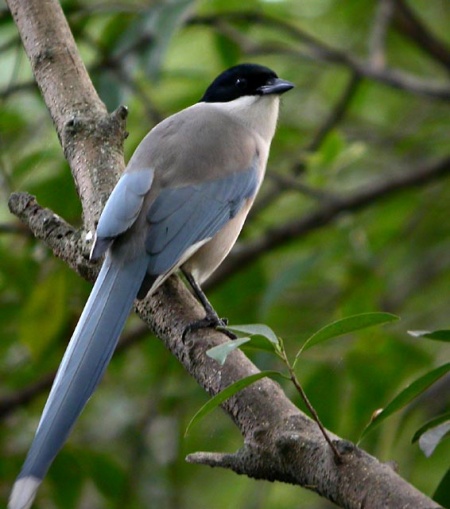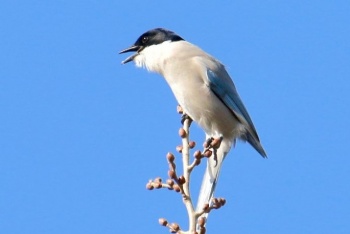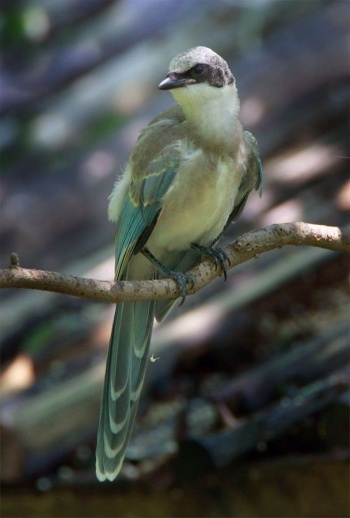- Cyanopica cyanus
Cyanopica cyana
Identification
Length 31-35 cm (13-13¾ in), of which the tail 16-20 cm; weight 76-118 g
- Glossy black cap
- White throat
- Brownish-grey back and rump
- Light buffish underparts
- Azure blue wings and tail
- White tip to tail
Sexes similar. Juveniles have a brownish-black hood.
Distribution
From central Asia to eastern China and Japan.
Taxonomy
Closely related to the Iberian Magpie, which was formerly included in this species, but differs in having an all-blue tail (no white tip) and slightly darker body plumage.
Subspecies
Eight subspecies are accepted here,[1] though C. c. pallescens is considered a synonym of C. c. cyanus by some authors:[2]
- C. c. cyanus: East-central Asia
- C. c. pallescens: Middle and lower Amur River region
- C. c. koreensis: Korea
- C. c. stegmanni: Manchuria
- C. c. swinhoei: Eastern China (Liaoning to Fujian and Sichuan)
- C. c. interposita: Northern China (Shaanxi)
- C. c. kansuensis: Western China (Gansu, Qinghai and north-western Sichuan)
- C. c. japonica: Japan (Hondo and Kyushu)
Habitat
Open mixed forest, scrub, orchards, parks and gardens.
Behaviour
Gregarious, forming noisy groups out of the breeding season. Largely resident, but northernmost populations more dispersive; higher altitude birds in Japan are also known to move to lower altitudes in winter.[2]
Diet
The diet includes a wide variety of nuts, invertebrates and larvae, soft fruits and berries. When seeking invertebrates on the ground, they like to jump forward both feet together.
Breeding
They nest in loose, open colonies with a single nest in each tree, usually a holm oak. Incubation takes around 15 days for the 6–8 eggs.
References
- Clements, J. F., T. S. Schulenberg, M. J. Iliff, D. Roberson, T. A. Fredericks, B. L. Sullivan, and C. L. Wood. 2018. The eBird/Clements checklist of birds of the world: v2018. Downloaded from http://www.birds.cornell.edu/clementschecklist/download/
- Del Hoyo, J, A Elliott, and D Christie, eds. 2009. Handbook of the Birds of the World. Volume 14: Bush-shrikes to Old World Sparrows. Barcelona: Lynx Edicions. ISBN 978-8496553507
- Avibase
- Wikipedia contributors. (2019, March 9). Azure-winged magpie. In Wikipedia, The Free Encyclopedia. Retrieved 18:40, June 3, 2019, from https://en.wikipedia.org/w/index.php?title=Azure-winged_magpie&oldid=886962334
- Peterson, RT, G Mountfort and PAD Hollom. 1993. Collins Field Guide – Birds of Britain and Europe, 5th Revised edition. London: HarperCollins Publishers. ISBN 978-0002199001
- Grant, P.J., K. Mullarney, L. Svensson, D. Zetterstrom (1999) Collins Bird Guide: The Most Complete Field Guide to the Birds of Britain and Europe. Harpercollins Pub Ltd ISBN 0 00 219728 6
- Boesman, P. (2016). Notes on the vocalizations of Iberian Azure-winged Magpie (Cyanopica cooki) and Asian Azure-winged Magpie (Cyanopica cyanus). HBW Alive Ornithological Note 204. In: Handbook of the Birds of the World Alive. Lynx Edicions, Barcelona. (retrieved from http://www.hbw.com/node/932151 on 9 June 2017).
- Fok, K.W., Wade, C.M. & Parkin, D.T. (2002) Inferring the phylogeny of disjunct populations of the azure-winged magpie Cyanopica cyanus from mitochondrial control region sequences. Proc. Roy. Soc. London (Ser. B Biol. Sci.) 269: 1671–1679.
- Kryukov, A., Iwasa, M.A., Kakizawa, R., Suzuki, H., Pinsker, W. & Haring, E. (2004) Synchronic east–west divergence in azure-winged magpies (Cyanopica cyanus) and magpies (Pica pica). J. Zool. Syst. Evol. Res. 42(4): 342–351.
- Madge, S. (2017). Asian Azure-winged Magpie (Cyanopica cyanus). In: del Hoyo, J., Elliott, A., Sargatal, J., Christie, D.A. & de Juana, E. (eds.). Handbook of the Birds of the World Alive. Lynx Edicions, Barcelona. (retrieved from http://www.hbw.com/node/60742 on 9 June 2017).
- Madge, S. & Burn, H. (1994) Crows and Jays: A Guide to the Crows, Jays and Magpies of the World. Houghton Mifflin, Boston.
Recommended Citation
- BirdForum Opus contributors. (2024) Azure-winged Magpie. In: BirdForum, the forum for wild birds and birding. Retrieved 16 April 2024 from https://www.birdforum.net/opus/Azure-winged_Magpie
External Links
GSearch checked for 2020 platform.






